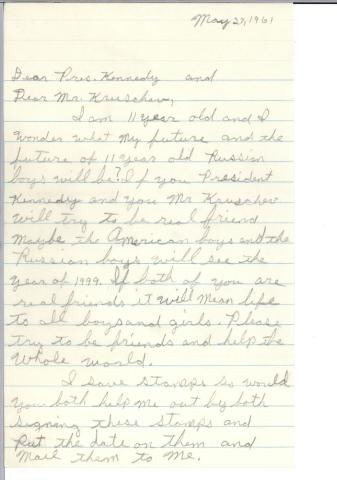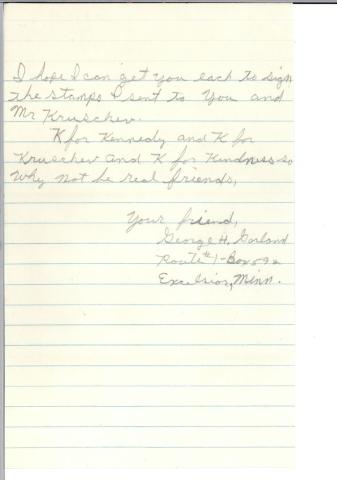Overview
Topic: Civic Education and Engagement, International Relations, Persuasive Writing and Speaking
Grade Level: 4-6
Subject Area: Civics and US Government, English Language Arts, US History
Time Required: 1 class period
Goals/Rationale
Students learn that the First Amendment of the Bill of Rights guarantees several rights, including freedom of speech and the right to petition the government for redress of grievances. By analyzing a letter from an eleven-year-old boy to President Kennedy, students discover that young people have the right to take civic action on issues of concern. They learn that US President John F. Kennedy and USSR Premier Nikita Khrushchev were leaders of two countries in conflict during the Cold War and what impact that tension had on young people.
Essential Question:
How does the Bill of Rights empower young people to participate in a democracy?
Objectives
Students will be able to:
- identify the First Amendment rights
- analyze a primary source document
- use their First Amendment rights to express their views on a world issue
Materials
Prior Knowledge and Skills
It is helpful for students to be familiar with the Constitution and the Bill of Rights.
Historical Background and Context
A strong democracy depends on civic engagement -- active citizens who participate in government and exercise their rights. By learning about the US Constitution, students can develop the civic knowledge they need to take civic action and participate fully in their communities and government. For young students, the First Amendment of the Bill of Rights provides accessible content about rights and freedoms. By analyzing primary sources from a different period in time, students can learn how people in the past have exercised their First Amendment rights. These examples can guide and inspire students to take civic action in their own lives.
The John F. Kennedy Presidential Library and Museum archive contains hundreds of thousands of letters from people of all ages who exercised their First Amendment rights by writing a letter to President Kennedy. Many of these messages can be considered petitions because they make requests of the president of the federal government. The authors also exercised their freedom of speech as they agreed or disagreed with Kennedy’s actions, shared information, and gave advice to the president and other government officials.
In the letter dated May 27, 1961, George Garland, an eleven-year-old boy from Exelsior, Michigan writes to “Pres. Kennedy” (President of the United States John F. Kennedy) and “Mr. Khrushchev” (Premier of the Soviet Union) to “please try to be friends and help the whole world.” The letter shows evidence of deep concern as George “wonders” about his future and that of Russian boys. By suggesting that a friendship between Kennedy and Khrushchev might enable “American boys and Russian boys to see 1999,” the author implies that the future of the world rests in the hands of the two leaders. Neither a response, the stamps mentioned in the letter, nor evidence of a letter to Soviet Premier Nikita Khrushchev could be found in the Kennedy Library archival collections. George Garland’s letter, which references his worries about the future, conveys a sense of imminent danger. What was happening at that time to warrant such concern from an eleven-year-old boy?
According to the date on the letter, May 27, 1961, it was written five days before Kennedy’s much anticipated visit with Khrushchev in Vienna, Austria. The meeting was an historic event because of the conflict and tension between the United States and the USSR. The United States and its allies were in a decades-long struggle with the Soviet Union known as “The Cold War” that had begun after World War II. The two superpowers did not engage in direct combat, but continually antagonized each other through political maneuvering, military coalitions, espionage, propaganda, arms buildups, economic aid, and proxy wars between other nations.
In June 1961, Kennedy met with Khrushchev in Vienna, Austria. The stakes were high since both countries had nuclear weapons. The threat of nuclear war was so real to people that they had fallout shelters in their homes and communities in case of a nuclear disaster. Not only was the summit unsuccessful in its goal of building trust between the two countries, but it raised tensions between the two superpowers--particularly in discussions regarding the city of Berlin.
As a result of these threatening developments, Kennedy ordered substantial increases in American intercontinental ballistic missile forces. He also added five new army divisions and increased the nation's air power and military reserves. The Soviets meanwhile resumed nuclear testing and President Kennedy responded by reluctantly reactivating American tests in early 1962. The two superpowers came dangerously close to nuclear conflict in October 1962 when the United States discovered missile sites built by the Soviet Union on Cuba, but they eventually resolved the crisis through diplomacy. In the final months of the Kennedy presidency, Cold War tensions seemed to soften as the Limited Nuclear Test Ban Treaty was negotiated and signed. In addition, Washington and Moscow established a direct line of communication known as the "Hotline" to help reduce the possibility of war by miscalculation.
For additional historical information, see the following topic guides:
Procedure
- Discuss the meaning of rights and brainstorm a list of rights that students have, such as the right to go to school or the right to go into a store.
- Explain that there are rights that are protected by the Constitution, the document that lays out how the government works. The Constitution also includes the Bill of Rights, the first ten amendments or changes to the constitution.
- Explain that the First Amendment has “five rights in one” and they can remember them using the acronym RAPPS (see poster). Discuss each freedom and give examples.
- Freedom of Religion: The freedom to choose what religion to practice (or to choose no religion at all.)
- Freedom of Assembly: The freedom to peacefully assemble and address important issues.
- Freedom of the Press: The freedom of news organizations to report about what is going on in towns, cities, states, and the world.
- Freedom to Petition: The freedom to write to government officials with our opinions and ideas.
- Freedom of Speech: The freedom to share our perspectives about things happening in the world.
- Explain that in the United States, these freedoms or rights are protected for people of all ages by the Bill of Rights. They are going to explore a document to see how young people’s rights were protected in the past and how they can use their rights today.
- Introduce the document dated 5/27/61. Have the students work in groups to analyze and discuss the letter.
- What is the date of the letter? (May 27, 1961)
- Who is the letter to? (President Kennedy and Premier Khrushchev)
- Who is the letter from? (George H. Garland)
- How old is the sender? (Eleven years old)
- Where is the author of the letter from? (Michigan)
- What is the concern of the author? What is the purpose of the letter?
- What is your favorite part of the letter? Why?
- What questions do you have?
- Address students’ questions or guide them to find information about Kennedy and Khrushchev.
- Prompt students to think about RAPPS and the First Amendment. What freedom(s) is the author of the letter exercising by writing this letter to Kennedy and Khrushchev? (Freedom of Speech, Freedom to Petition the Government – this is a request of the president to be friends with Khrushchev.)
- Ask students what they are concerned about in the world. Brainstorm how they can use their First Amendment freedoms to address the issue. Work individually, or as a class to take civic action on one or more of the issues.
Assessment
Have students write a letter to an elected official about a concern they have about a foreign policy situation. Have them research the situation and locate the countries in question on a globe or map. What are they concerned about? Why are they concerned? Have students include any suggestions to address the issue.
Additional Resources
Write a Letter to the President: Students can watch a 15-minute video about the importance of letter writing which provides examples of letters to President Kennedy from young people, and guides students to write their own letter to the president. Includes letter writing templates.
The First Amendment: Five Rights in One!: In this 45-minute interactive virtual program, students explore the First Amendment freedoms through historical primary sources from the National Archives. It is offered as a part of “We Rule: Civics for all of US”. Visit the National Archives civic education programs for more information, including how to request a program for groups of 10 or more students.
Connections to Curriculum (Standards)
National History Standards:
Standard 3: Historical Analysis and Interpretation
Common Core State Standards
ELA College and Career Readiness Anchor Standards for Reading, Writing, Speaking and Listening, and Language
NCSS C3 Framework
Discipline 2 - Applying disciplinary concepts and tools (History and Civics)
Discipline 3 - Evaluating sources and using evidence
Massachusetts History and Social Studies Frameworks
5.T3 Principles of United States Government


